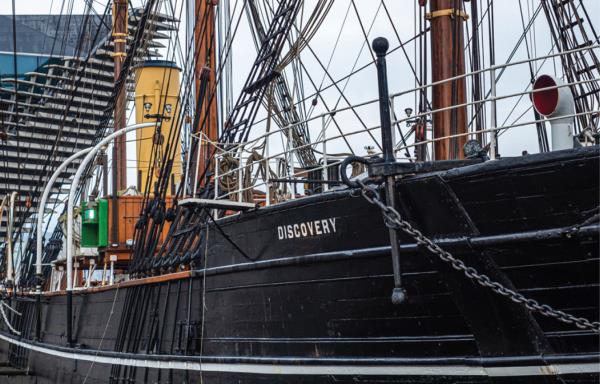04 July 2024

The National Oceanography Centre (NOC) is at the forefront of research in large-scale oceanography and ocean measurement technology innovation. The UK-based NOC is one of the world’s top oceanographic institutions employing around 650 staff. The NOC supports scientists in universities and research institutes with facilities, research infrastructure and irreplaceable data assets; and additionally manages Europe’s largest fleet of autonomous and robotic vehicles, and two state-of-the-art research ships - RRS Discovery and RRS James Cook.
Refurbish and upgrade
The NOC had planned to refurbish RRS Discovery and RRS James Cook and identified an opportunity to install a robust and secure IT infrastructure solution onboard both vessels. Connectivity is an essential aspect aboard a research vessel amidst the vast ocean, and given the rarity of such refits, this presented a unique opportunity to establish modern levels of connectivity and state-of-the-art security onboard each vessel.
The primary objective was to provide an up-to-date, high speed, and secure network and IT infrastructure. Emphasis was placed on security, especially considering the prevalent challenges posed by malicious attacks, ransomware, and data breaches. Considering that the vessels continuously amass substantial volumes of research data, which serves as the foundation for scientists’ research papers and academic degrees, the pivotal task was to efficiently store, secure, and provide seamless accessibility to this data across the vessels’ various devices.
Pre-staging equipment
Logicalis was tasked with installing both indoor and outdoor elements, including access points mounted on masts. Upon embarking on their journey, the outdoor components would be subjected to extreme weather conditions from Equatorial to Arctic and the Antarctic. Therefore, Logicalis was required to design a solution that could withstand the harshest of weather conditions.
The RRS Discovery and RRS James Cook pose significant architectural obstacles to the installation of IT infrastructure. Despite their considerable size, the vessels’ limited space is primarily allocated to research equipment and the storage of provisions necessary for sustained periods at sea.
Consequently, the implementation of any IT solution had to be executed within highly constrained physical parameters and be appropriately sized to fit into the available space. Additionally, the metallic composition of the research vessels poses a significant challenge to the design of any wireless solution.
The refit completion date was fixed, as RRS Discovery and RRS James Cook were scheduled to depart on a specific date. Accordingly, updating the onboard network had to be started and completed within a narrow window of opportunity.
Given the time constraints, a pre-staging process became imperative. Over three months, Logicalis pre-staged all wireless networking equipment at the NOC building in Southampton. The project team tested and ensured the functionality of every component whilst overcoming any challenges during the testing phase. Once the customer approved the solution, the equipment was swiftly transferred onto the ship, which then continued on its journey to Scotland, where a team of Logicalis engineers undertook the physical installation of the network.
While testing is important for every project, this one added a distinct dimension of urgency, as all challenges had to be successfully addressed and resolved within an immovable deadline. The timeline for delivering the solution was initially constrained by manufacturer supply times. The process began with the design and sign-off, which took approximately 12 weeks, followed by the pre-build, equipment staging, and off-board testing on both ships, spanning 14 weeks. The installation and testing on each vessel required 2 weeks, while the final knowledge transfer preparation and sessions for the operations team took an additional 2 weeks. Overall, the entire elapsed time accounted for 11 months, primarily due to equipment dependencies. The physical progress, from kick-off to operational handover, extended over 32 weeks.
All aboard
The partnership successfully delivered on the deployment of an advanced and all-encompassing wireless infrastructure solution that ensures improved levels of security to keep research data safe and in the right hands. As a result of the success of this partnership, the NOC has entered into a 12-month managed service agreement with Logicalis.
In adherence to Logicalis’ proposed strategy, the project executed its outlined objectives:
- High speed and highly available server and storage solution with up to four times more capacity than the ships previous solution in a smaller footprint.
- High-speed data backup and recovery.
- Multi-gigabit network backbone.
- Network segmentation and software defined access control.
- Centralised user authentication and role-based access.
- Wired and wireless network access throughout the ships.
- Software Defined Wide Area Network connectivity through satellite, 4G and point-to-point networks.
- High speed ship-to-shore connectivity in the home port.
- Guest WiFi internet access.
The individuals onboard now experience enhanced WiFi coverage encompassing the entire vessel. From the IT administrators’ standpoint, the primary advantage lies in the significantly enhanced cybersecurity on board, along with an integrated solution that facilitates seamless wireless connectivity between the vessel and the NOC headquarters upon arrival at port.
“Resilient and robust IT systems are fundamental to supporting the work and research we do at sea,” says Juan Ward, head of the ships scientific system team, National Oceanography Centre. “The Logicalis team worked tirelessly to deliver the project against a complex set of requirements and the backdrop of global supply chain issues. We are pleased that their solution significantly increases the security of the onboard IT infrastructure, decreasing risks to research data, scientific systems and marine business systems, whilst at the same time enhancing the user experience with WiFi throughout the ship and high-speed connectivity when alongside in Southampton.”








